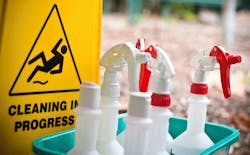Safety continues to be a major concern in professional cleaning. Invariably, cleaning workers focus on cleaning chemicals, equipment and tools to perform their tasks, but safety equipment often takes a backseat.
“Cleaning workers suffer more injuries than many other workers in private industry,” says Vicky Adams, category manager for safety, gloves and foodservice products for Impact Products. “Studies going back to 2007 find that full-time custodians are injured on the job sometimes as much as two times that of other workers in private industry.”
Female cleaning workers in particular have a high rate of injury. Women comprise only about one-third of janitorial workers nationwide, according to data from the U.S. Bureau of Labor Statistics, but in one study, women filed more than half of the compensable injury claims for janitorial workers from 2003 through 2012. While this can vary, it appear that due to their smaller number and higher percentage of claims, women janitors have almost twice the number of compensable injuries as do male janitors.
Impact Products offers this safety supply checklist specifically for cleaning workers:
- Aprons: This is the next “must have” item when it comes to janitorial worker safety. Lightweight, vinyl aprons protect the wearer from chemical spills and sprays, grease, oil, punctures and abrasives
- Hand protection: Each year, 1 million people visit hospital emergency rooms in the United States because of injuries to their hands. As much as 70 percent of these injuries could be prevented if the proper hand protection was worn.
- Protective eyewear: Approximately 2,000 work-related eye injuries occur in the United States every day. Often these are the result of chemicals splashing in the eye. Almost all of these injuries – 90 percent – could be prevented by wearing proper eye protection that meets ANSI standards.
- Back injuries: Back injuries account for about 46 percent of all cleaning-related injuries. Most of these can be prevented by proper training in lifting and general ergonomic awareness.
- Shoes: One of the most dangerous cleaning tasks involves cleaning or refinishing floors. The danger arises because the floors become so slippery during the process. Cleaning workers should considering wearing “grippers” when stripping floors; some are designed to fit right over work shoes, helping to prevent a slip-and-fall accident. Slip-resistant footwear is important when cleaning floors or mopping up spills.
- Floor safety signs: Usually safety signs are installed around floors to protect building users. However, they also should be installed where cleaning workers can see them.
About the Author

Sandy Smith
Sandy Smith is the former content director of EHS Today, and is currently the EHSQ content & community lead at Intelex Technologies Inc. She has written about occupational safety and health and environmental issues since 1990.
